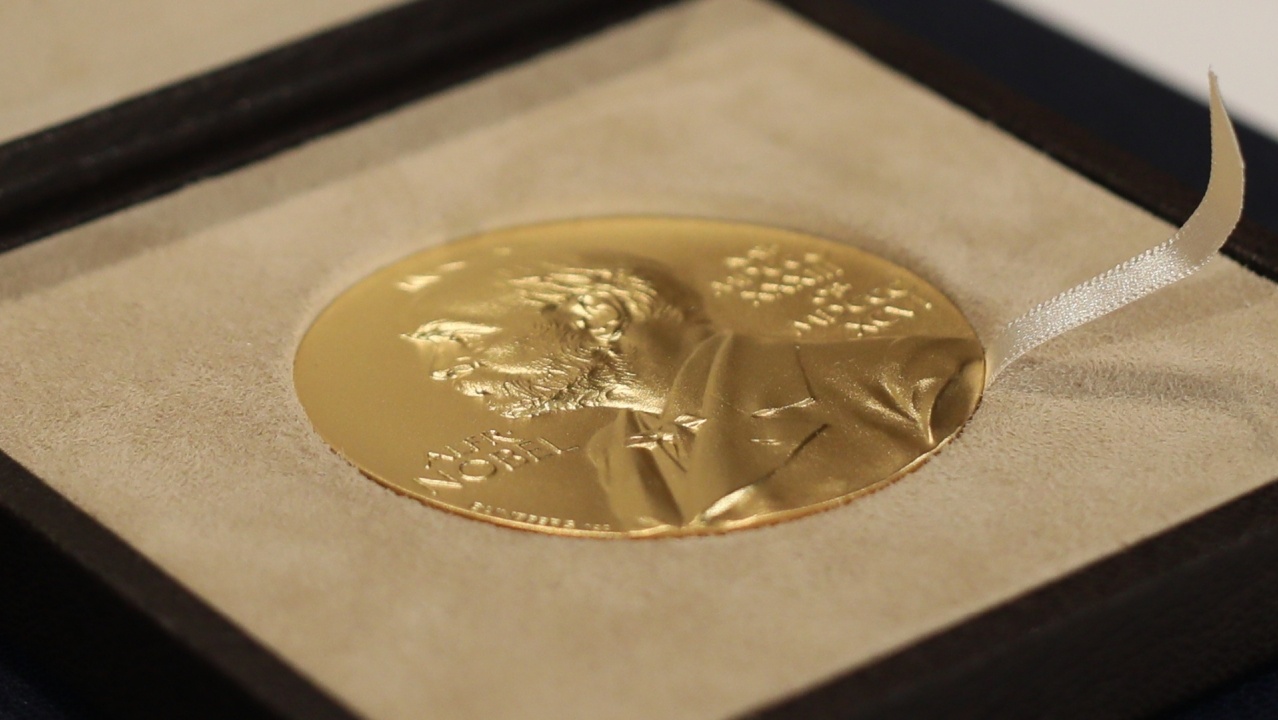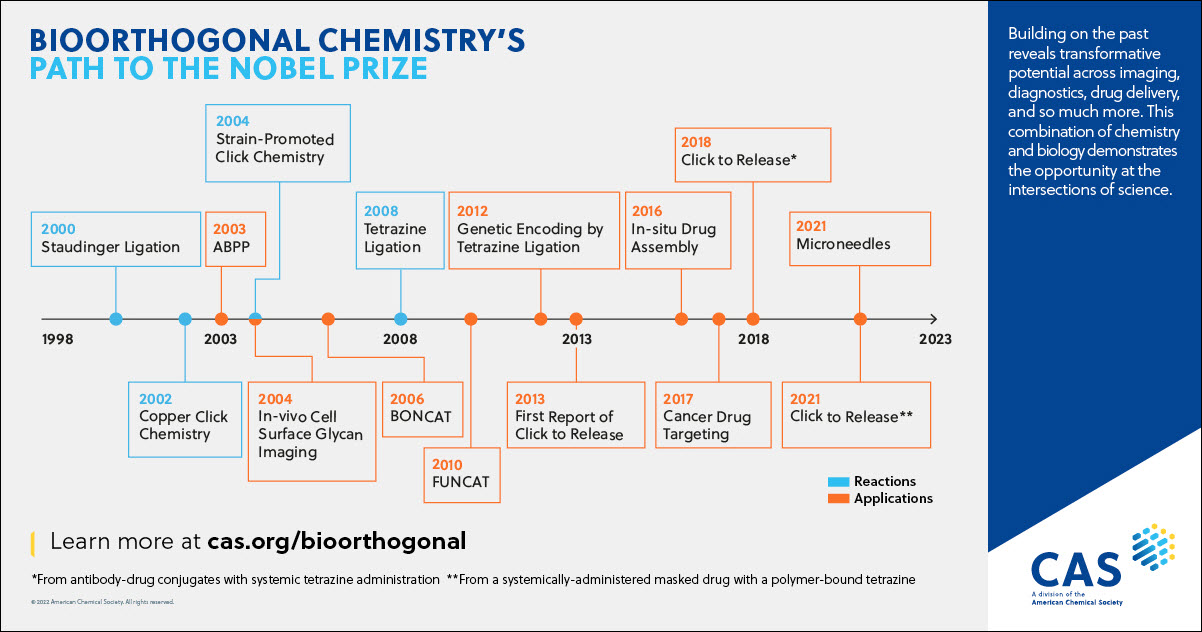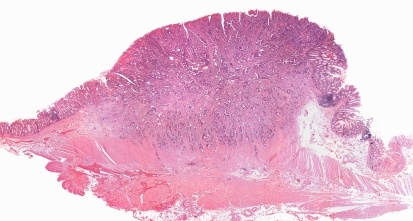Gain new perspectives for faster progress directly to your inbox.

The 2022 Nobel Prize in Chemistry goes to Carolyn R. Bertozzi, Morten Meldal, and K. Barry Sharpless for the development of click chemistry and bioorthogonal chemistry. Their work describes reactions that can be used to rapidly connect molecules under ambient or biological conditions. This research has wide applications and has been used from polymers and pharmaceuticals to studying biological mechanisms and developing new biotherapeutics.
CAS Resources on bioorthogonal chemistry: Insight Report, Journal Publication in Bioconjugate Chemistry, Article on the role of Sugars in Bioorthogonal Chemistry
What is click chemistry?
Click chemistry is a set of rapid and specific reactions for assembling fragments into more complex structures. The term click chemistry was coined by Professor K. Barry Sharpless, who envisioned the formation of enzyme inhibitors by coupling smaller molecules in the active site of an enzyme. His and Morten Meldal’s laboratory developed regioselective copper-catalyzed versions of the Huisgen cycloaddition of azides and terminal alkynes to form 1,2,3-triazoles. This method has been used for the preparation of polymers, antibodies, and pharmaceuticals because of its ease and reliability. Other click reactions, such as thiol-ene and SuFEx reactions, have also been developed, particularly for use in polymers.
About 30,000 documents in the CAS databases have used the concept “click chemistry”. The earliest reference to “click chemistry” in the CAS databases was in 1999 (“Click chemistry: a concept for merging process and discovery chemistry” (with H. C. Kolb), Book of Abstracts, 217th ACS National Meeting, Anaheim, Calif., March 21-25 (1999), ORGN-105 Publisher: American Chemical Society, Washington, D.C.) while the group’s earliest reference on the azide-alkyne cycloaddition reaction was in 2002. The most cited document by the Sharpless group on click chemistry, “Click chemistry: diverse chemical function from a few good reactions” has been cited more than 11000 times.
What is bioorthogonal chemistry?
Bioorthogonal chemistry (a term first used by Carolyn Bertozzi in the late 1990’s) describes reactions that occur rapidly under biological conditions (at or near room temperature, in aqueous solutions, in the presence of biological molecules, and at low concentrations). Many molecules with different functional groups are present in cells, and reactions that react selectively with a single functional group would be useful to understand the behavior of biological systems.
Carolyn Bertozzi and her research group first developed the Staudinger reactions of azides with ester-substituted triarylphosphines for use in the study of carbohydrates in biological systems. Copper catalysts necessary to make azide-alkyne cycloadditions rapid under biological conditions at room temperature are toxic to cells. The Bertozzi laboratory developed strained cyclic alkynes based on work performed by Wittig and Krebs in the early 1960’s. The cyclic alkynes undergo strain-promoted azide-alkyne cycloadditions (SPAAC) without a catalyst and at room temperature and, thus can be used in living cells. SPAAC has been important for viewing and understanding biological processes in living cells. A variety of other bioorthogonal reactions have been developed.
Roughly 3000 documents in the CAS databases have used the term “bioorthogonal chemistry”, of which the earliest reference was to the Ph. D. thesis of G. A. Lemieux, a doctoral student in Professor Bertozzi’s laboratory. The development of bioorthogonal reactions by Professor Bertozzi’s laboratory is discussed in “From Mechanism to Mouse: A Tale of Two Bioorthogonal Reactions”. An overview of bioorthogonal reactions is given in a separate review, which is also the most cited article by the Bertozzi group discussing bioorthogonal chemistry, with more than 2400 citations.
What does the path to the Nobel Prize look like?
Bioorthogonal chemistry has grown remarkably in the last two decades and has found more widespread use in recent years. Notable developments and applications in the field are summarized in the timeline here.

Additionally, the CAS Content Collection was analyzed to compare the rise in publications of bioorthogonal terms and the increase in applications of bioorthogonal chemistry.
This shows that imaging was the single biggest use of bioorthogonal chemistry between 2010 and 2020, followed by pharmaceutical applications. The use of bioorthogonal chemistry for labeling was reported in nearly as many documents as its use in pharmaceuticals, though labeling is likely to represent a variety of uses not otherwise characterized. Similar numbers of documents used bioorthogonal chemistry in hydrogels or diagnostic agents for mechanistic or mass spectrometric studies.
What are the opportunities ahead for bioorthogonal chemistry?
The fields of imaging, diagnostics, and drug delivery have been transformed by these approaches, but there are more opportunities ahead in the following areas:
- Explore the development of reactive partners with improved biological stabilities, or simplify methods by eliminating the need for catalysts (reducing toxicities)
- Multiple labeling could allow for easier exploration of biologic mechanisms and more reliable diagnostic agents
- Improved light-activated chemistries could minimize damage to organisms and allow imaging from even deeper within living organisms
These methods have enabled easier and more reliable synthesis, a better understanding of biological mechanisms, and the development of more effective and selective treatments. Their work has advanced progress across chemistry, biology, and medicine, enabling work that otherwise would not be possible. For a unique landscape view of this field, download our Insight Report that builds upon the historical trends to highlight the opportunities ahead for bioorthogonal chemistry, or check out the peer-reviewed publication.



